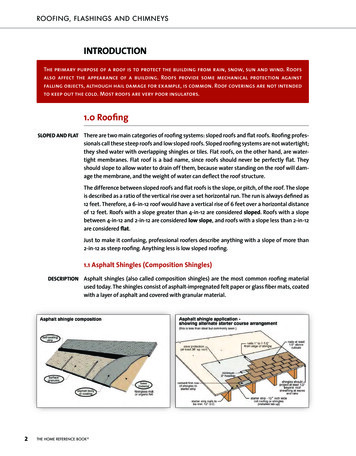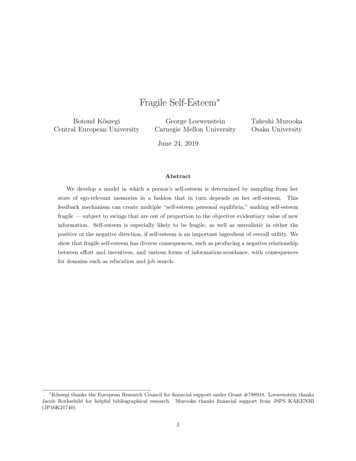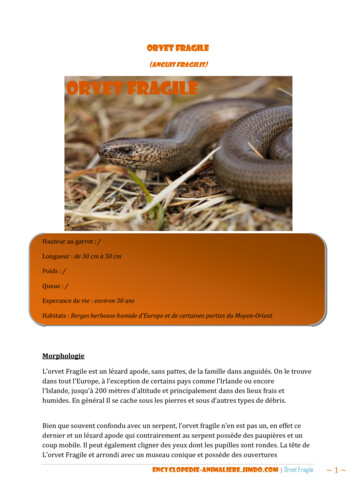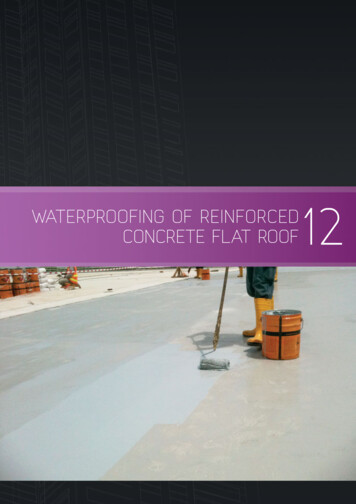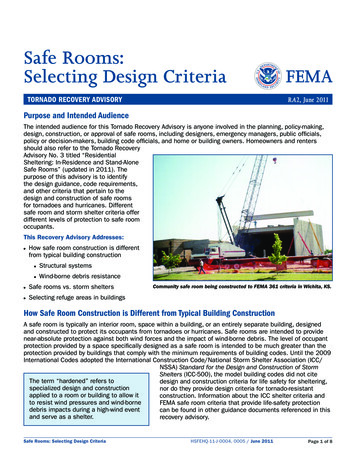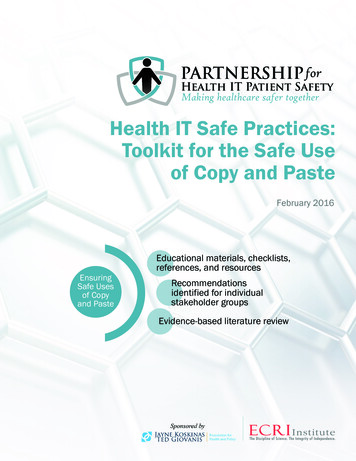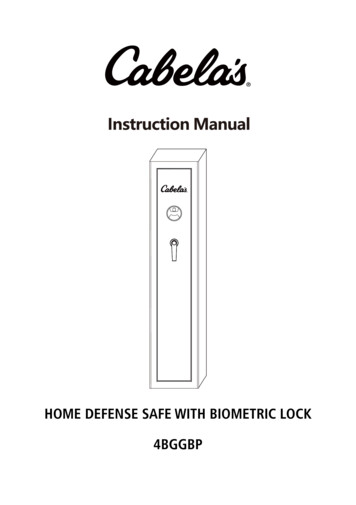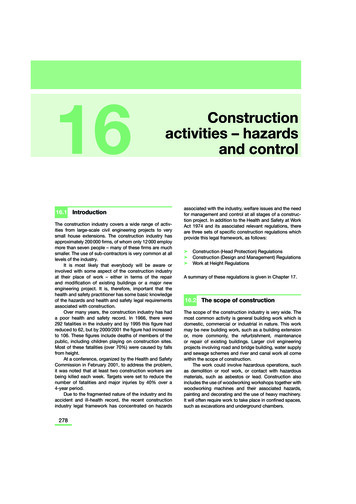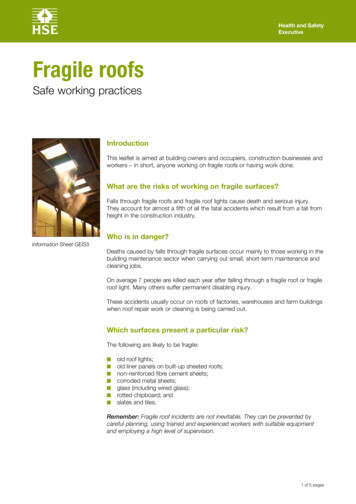
Transcription
Health and SafetyExecutiveFragile roofsSafe working practicesIntroductionThis leaflet is aimed at building owners and occupiers, construction businesses andworkers – in short, anyone working on fragile roofs or having work done.What are the risks of working on fragile surfaces?Falls through fragile roofs and fragile roof lights cause death and serious injury.They account for almost a fifth of all the fatal accidents which result from a fall fromheight in the construction industry.Who is in danger?Information Sheet GEIS5Deaths caused by falls through fragile surfaces occur mainly to those working in thebuilding maintenance sector when carrying out small, short-term maintenance andcleaning jobs.On average 7 people are killed each year after falling through a fragile roof or fragileroof light. Many others suffer permanent disabling injury.These accidents usually occur on roofs of factories, warehouses and farm buildingswhen roof repair work or cleaning is being carried out.Which surfaces present a particular risk?The following are likely to be fragile: old roof lights;old liner panels on built-up sheeted roofs;non-reinforced fibre cement sheets;corroded metal sheets;glass (including wired glass);rotted chipboard; andslates and tiles.Remember: Fragile roof incidents are not inevitable. They can be prevented bycareful planning, using trained and experienced workers with suitable equipmentand employing a high level of supervision.1 of 5 pages
Health and SafetyExecutiveWhat you should do as a building owner or occupierBefore work starts: Ensure that a competent person assesses the roof using a safe system of work(see below). Ensure the work is properly planned in advance by a contractor with sufficientexpertise in working on fragile roofs. Specify non-fragile assemblies for new and replacement roofs. Satisfy yourself that the contractors have allowed sufficient time to carry out thework safely.After work starts: Ensure the planned safe system of work is implemented.What is a safe system of work?AvoidanceAvoid workers having to go on the roof at all by adapting a method that allowsprofiled roof sheets or roof lights to be replaced from underneath using a suitablework platform – this may involve the use of adapted roof fixings, available frommaterials suppliers. The National Federation of Roofing Contractors can advise(www.nfrc.co.uk).PreventionIf the work cannot be done from underneath and workers need access to thetopside of the roof: use a mobile elevating work platform (MEWP) that allows people to work fromwithin the basket without standing on the roof itself.If access onto the fragile roof cannot be avoided, mitigate fall distance andconsequences: install perimeter edge protection and use stagings on the roof surface to spreadthe loads; ensure all the work and access stagings or platforms are fitted with guard rails; if this is not possible, install safety nets underneath the roof or use a harnesssystem; and where harnesses are used, make sure they have adequate anchorage pointsand they are properly used – through appropriate discipline, training andsupervision.Note: Proprietary covers, which can serve as either a temporary or a permanentinstallation, are available to prevent someone who is passing or working near fragilematerial from falling through.Safe systems of work must be planned and followed to protect those installing thesafety measures.Fragile roofsSafe working practices2 of 5 pages
Health and SafetyExecutiveWhat enforcement action might be taken by HSE?Working on fragile surfaces is extremely dangerous and the precautions are wellestablished.The law says you must organise and plan all roof work so it is carried out safely. Ifinspectors encounter failure to control risk, work will be prohibited and prosecutionmay follow.Examples of safe systems of workSafe systems for replacing roof sheets and roof lights from underneathRemoving hook bolts from existing sheetLocating replacement sheetSecuring fixings to newly installed sheetFragile roofsSafe working practices3 of 5 pages
Health and SafetyExecutiveMobile elevating work platformsUsing a MEWP to inspect a ventUsing a MEWP to clean a gutterUsing netting to provide protectionSafety netting used to provide protection forroof lights during minor roof worksCovers can be fitted to existing roofs or included as part of the design(Image courtesy of Safesite)Fragile roofsSafe working practices4 of 5 pages
Health and SafetyExecutiveFurther readingWorking on roofs Leaflet INDG284(rev1) HSE Books 2008 (priced packsISBN 978 0 7176 6288 3) www.hse.gov.uk/pubns/indg284.pdfHealth and safety in roof work HSG33 (Fourth edition) HSE Books 2012ISBN 978 0 7176 6250 0 www.hse.gov.uk/pubns/books/hsg33.htmSafe working on fragile roofs or roofs with fragile elements ACR(CP) 002: 2012 (TheGreen Book) Advisory Committee on Roofsafety www.roofworkadvice.infoPlanning minor works Information Sheet No 3: 2012 Advisory Committee onRoofsafety www.roofworkadvice.info (aimed at clients and building owners)Further informationFor information about health and safety, or to report inconsistencies or inaccuraciesin this guidance, visit www.hse.gov.uk/. You can view HSE guidance online andorder priced publications from the website. HSE priced publications are alsoavailable from bookshops.This guidance is issued by the Health and Safety Executive. Following the guidanceis not compulsory, unless specifically stated, and you are free to take other action.But if you do follow the guidance you will normally be doing enough to comply withthe law. Health and safety inspectors seek to secure compliance with the law andmay refer to this guidance.This leaflet is available at: www.hse.gov.uk/pubns/geis5.htm. Crown copyright If you wish to reuse this information visit www.hse.gov.uk/copyright.htm for details. First published 11/12.Published by the Health and Safety ExecutiveGEIS511/125 of 5 pages
where harnesses are used, make sure they have adequate anchorage points and they are properly used - through appropriate discipline, training and supervision. Note: Proprietary covers, which can serve as either a temporary or a permanent installation, are available to prevent someone who is passing or working near fragile
